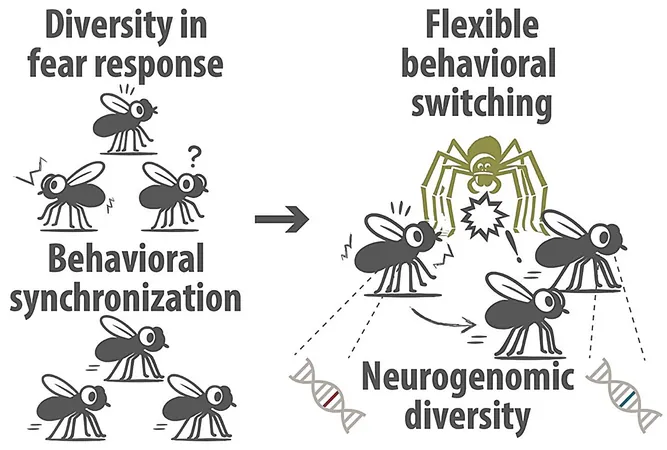
Unlocking Survival Secrets: How Fruit Flies Overcome Fear with Collective Intelligence
2025-07-07
Author: Rajesh
The Power of Collective Behavior in the Animal Kingdom
From schools of fish evading sharks to flocks of starlings dancing in the sky, nature is full of stunning examples showcasing how group dynamics can enhance survival. Animals that band together are often better at detecting threats and coordinating escapes, which significantly boosts their chances of survival and makes scavenging for food more efficient.
The Genetic Puzzle Behind Group Behaviors
Despite the obvious benefits of collective behaviors, the intricacies of the genetic and neural mechanisms that fuel these actions largely remain a mystery. Traditional genetic studies have a knack for linking gene variations to individual traits, but group behaviors arise from a complex web of interactions between multiple individuals, each with its own genetic makeup. Consequently, conventional genome-wide association studies (GWAS) often fall short when trying to decode the emergent properties of group dynamics.
A Groundbreaking Study with Fruit Flies
To unravel this enigma, a research team from Chiba University in Japan, led by Assistant Professor Daiki Sato and Associate Professor Yuma Takahashi, turned their attention to fruit flies. Their groundbreaking research, published in Nature Communications, delves into how these flies navigate their fear responses when faced with predators, shedding light on the survival advantages of genetic diversity.
Innovative Experiments Yield Surprising Results
In a bold experiment with 104 genetically diverse fruit fly lines, the team simulated predator attacks using visuals on a screen. Astonishingly, while individual flies often entered a long state of fear-induced paralysis, those in groups quickly returned to normal behavior upon witnessing their companions’ movements. This rapid recovery, termed "unfreezing," hinged on visual cues from their fellow flies.
Genetic Insights into Fear Response
Through GWAS, the scientists pinpointed genes impacting how flies react to social cues. Notably, the Ptp99A gene displayed significant connections for both male and female flies. This gene plays a crucial role in cellular and neural functions, influencing gene activity in neurons responsible for processing motion.
A Novel Analytical Approach: GHAS
The researchers introduced an innovative analytical method, the genome-wide higher-level association study (GHAS), designed to capture complex biological traits that emerge within groups. This approach focuses on genetic variations linked not to individual behaviors but to collective characteristics, allowing for a deeper understanding of how genetic diversity leads to behavioral diversity.
Survival Through Diversity: Real-World Applications
One of the study's most astonishing revelations was that genetic diversity within a group can amplify collective fear responses, boosting survival rates. When combining flies from different genetic lines, researchers noted a stronger initial response to threats than anticipated, enhancing their overall survival.
The team employed an animal-computer interaction approach, showcasing virtual flies on screens and observing how real jumping spiders reacted to various behaviors. The findings revealed that groups with varied freezing times gained a distinct advantage, reducing the risk of predation while remaining agile enough to hunt.
Exploring New Horizons in Research
Dr. Sato emphasized how this research sets the stage for understanding how genetic and neural diversity influences adaptive group behaviors. Its implications extend beyond fruit flies, potentially affecting pest control, advancements in robotics, and even insights into neurodevelopmental disorders.
Conclusion: A Leap Forward in Collective Behavior Research
Overall, this pioneering research marks a significant leap in comprehending the biological foundations and evolution of group behaviors. As researchers explore these findings across different species, the potential applications of this knowledge could revolutionize multiple fields.



 Brasil (PT)
Brasil (PT)
 Canada (EN)
Canada (EN)
 Chile (ES)
Chile (ES)
 Česko (CS)
Česko (CS)
 대한민국 (KO)
대한민국 (KO)
 España (ES)
España (ES)
 France (FR)
France (FR)
 Hong Kong (EN)
Hong Kong (EN)
 Italia (IT)
Italia (IT)
 日本 (JA)
日本 (JA)
 Magyarország (HU)
Magyarország (HU)
 Norge (NO)
Norge (NO)
 Polska (PL)
Polska (PL)
 Schweiz (DE)
Schweiz (DE)
 Singapore (EN)
Singapore (EN)
 Sverige (SV)
Sverige (SV)
 Suomi (FI)
Suomi (FI)
 Türkiye (TR)
Türkiye (TR)
 الإمارات العربية المتحدة (AR)
الإمارات العربية المتحدة (AR)